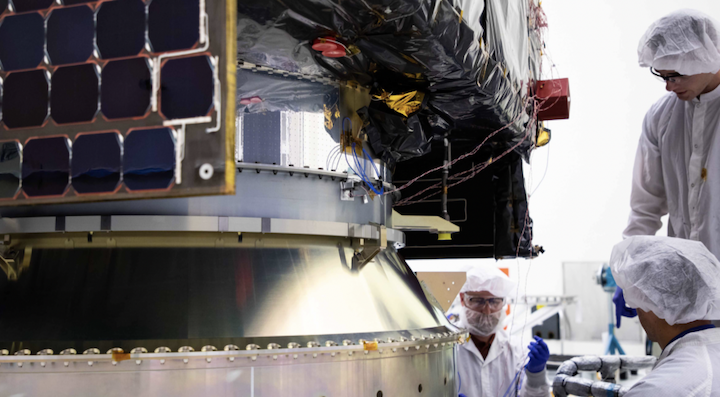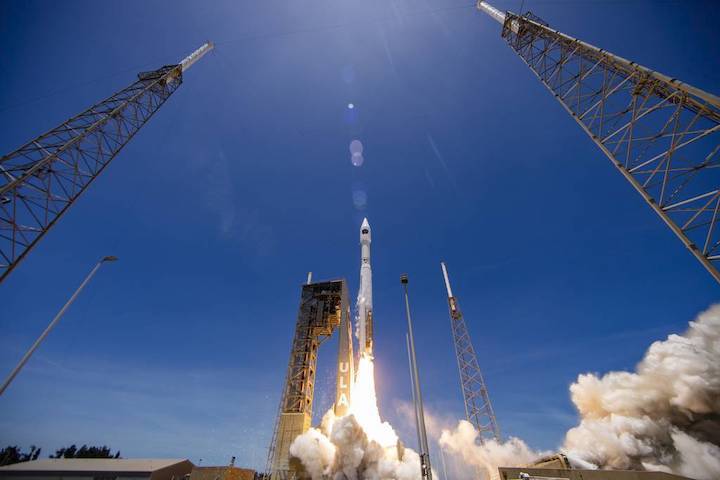16.03.2022
Launch of U.S. Space Force missile-warning satellite delayed indefinitely

WASHINGTON — The launch of a U.S. Space Force mission known as USSF-12 has been put on indefinite pause, for reasons that are not being disclosed.
USSF-12 was planned as a two-satellite mission that United Launch Alliance was preparing to launch in April on an Atlas 5 rocket. The primary payload is the geosynchronous Wide Field of View mid-size satellite equipped with a missile-warning sensor. A rideshare spacecraft was expected to fly an unspecified number of small satellites for military experiments.
ULA on March 9 announced that USSF-12 is being postponed “due to a customer request” but did not elaborate further. The Space Force confirmed March 12 that the launch of USSF-12 is being taken off the schedule for now.
“We have no specifics to offer at this time on the exact cause for the delay, but we are working to get USSF-12 back on the launch schedule as soon as possible,” a spokesperson for the U.S. Space Systems Command said in a statement to SpaceNews.
The manufacturer of the Wide Field of View satellite, Boeing’s Millennium Space Systems, in a statement March 14 said the payload was delivered last month to a launch processing facility at Cape Canaveral, Florida. The Atlas 5 rocket remains at the Cape ready to launch.
The Wide Field of View was shipped from the company’s facility in El Segundo, California, and “was delivered safely on February 2,” the company said in the statement.
“This satellite was procured by the Space Systems Command to serve as a testbed for Wide Field of View technologies in geosynchronous orbit for the missile warning mission, and as an enabling asset for the missile tracking and missile defense missions,” the company said.
The delay conceivably could be related to the secondary payload but neither the Space Systems Command nor Millennium Space would comment on that.
Wide Field of View will be put back in storage until the Space Force decides how to move forward. “We will share additional information regarding a new launch date when it is available,” the spokesperson said.
Wide Field of View has been in development since 2016. It was designed to test advanced technologies for missile warning, or the early detection of ballistic missile launches. It is not part of a missile-warning constellation but a stand-alone experiment. The satellite carries an infrared sensor made by L3Harris Technologies.
ULA received a contract in 2018 to launch USSF-12. The launch was initially targeted for 2020, and last year was put on the calendar for early 2022.
Quelle: SN
----
Update: 17.03.2022
.
US Space Force won’t say it why it delayed an upcoming Wide-Field-of-View Testbed launch

A United Launch Alliance rocket carrying the SBIRS GEO 5 mission for the U.S Space Force lifts off on May 18, 2021. A pathfinder mission for future missile warning capabilities set to launch in April has been delayed. (United Launch Alliance)
WASHINGTON — The U.S. Space Force is offering few details on its decision to delay the launch of its Wide-Field-of-View Testbed, which was set to lift off this spring.
“National security space launches are incredibly complex and can be delayed for any number of reasons,” spokesman Jim Spellman told C4ISRNET in an email. “All issues, concerns and questions must be satisfactorily resolved prior to moving forward.”
The WFOV testbed, a pathfinder mission meant to inform the Next-Generation Overhead Persistent Infrared program, is part of the USSF-12 mission, which also includes an Evolved Expendable Launch Vehicle Secondary Payload Adaptor with added propulsion, power and avionics. United Launch Alliance, the launch provider for the mission, announced last week it had been delayed “due to a customer request.”
Spellman said the service does not have a new projected launch timeline and declined to confirm whether the delay was related to the satellite or the launch vehicle.
“We have no specifics to offer at this time on the exact cause for the delay, but we are working to get USSF-12 back on the launch schedule as soon as possible,” he said.
The WFOV testbed, previously expected to launch in August 2021, was developed by Millennium Space Systems and includes an advanced missile warning staring sensor built by L3Harris Technologies. The experiment, destined for geosynchronous orbit, is designed to shape requirements for future Next-Gen OPIR capabilities and help the service better understand what future ground architecture may be needed to process larger amounts of data from advanced sensors.
Meanwhile, Lockheed Martin and Northrop Grumman are making progress on the Next-Gen OPIR program of record. Lockheed is developing three GEO satellites and Northrop two polar satellites, and both companies selected payload providersearlier this month.
Quelle: C4ISRNET

